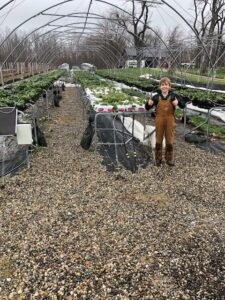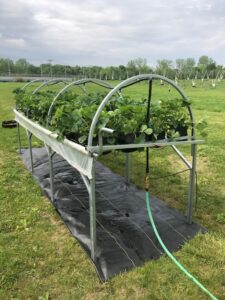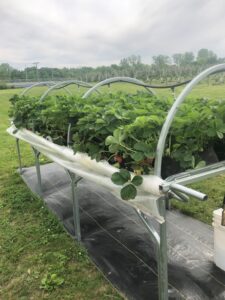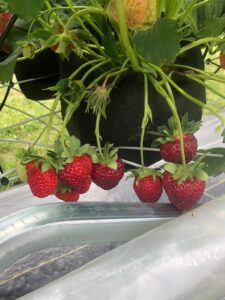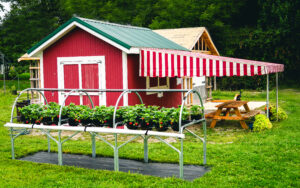Final report for FNC18-1111
Project Information
Three family-owned and -operated farms are participating in this team project. Founded in 2002, Tanglewood Berry Farm grows over 7 acres of berries and hops. Certified organic methods have been used on the 5 acre blackberry field since 2015 while conventional methods (excluding restricted use pesticides) are presently used on the remaining acreage. Rhoads Farm, Inc. has over 40 years of experience growing 35+ acres of strawberries, blackberries, peaches and vegetables. Conventional methods are used by Rhoads Farm in their crop production activities. Indiana Springs Berry Farm is a USDA certified organic 2-acre blackberry operation that was founded in 2016.
This project will evaluate the economic viability of small-scale strawberry production using an elevated cropping system under field conditions. Elevated cropping systems are currently used in controlled greenhouse environments where growers achieve high yields, quality fruit and efficient harvests. However, these systems are not adapted for field use. The biggest problems associated with using a field elevated system for strawberries are keeping soil temperatures below 77F and preventing excessive water loss.
The proposed system will be economical to build and uses a novel design to solve these problems. Growing troughs will be protected by reflective shade netting and constructed from materials with evaporative cooling properties. A media mix with low thermal conductivity will be used to reduce soil temperature changes. Wireless sensors will monitor soil moisture and temperature and signal the automated drip irrigation system. Efficient heat transfer, reflection of the sun’s radiation and timed irrigation events will regulate temperature and water levels.
Strawberries will be positioned at waist-level for easier harvesting and plant work. Workers should experience less stress on their backs and knees with this system compared to conventional ground systems. Workers will get health benefits while growers should see greater harvest efficiencies and higher profits.
- Identify strawberry cultivars which give the best yields and harvest efficiencies in an elevated field production system.
- Assess worker benefits of using an elevated field production system.
- Identify the most cost-effective configuration of wireless sensors and controllers to monitor soil media moisture and temperature (media and air).
- Evaluate the use of growing troughs and shade netting constructed from materials which can prevent heat build- up in the growing media through evaporative cooling, reflection of the sun’s radiation and thermal conductivity.
- Share findings at field days hosted in Indiana and Ohio, the farms’ Facebook websites and at a conference presentation.
Cooperators
- (Educator)
Research
This project uses a prototype elevated strawberry cropping system that is designed for field use in regions where labor efficiencies and temperature extremes can significantly reduce the profitability of small-scale strawberry production. Over-riding considerations for the development of a prototype system are: 1) return on investment for growers and 2) an ergonomic system designed to reduce worker fatigue.
Another important consideration was the ability to automate irrigation events. Targeted irrigation is used to keep moisture levels at appropriate levels for vegetative growth and fruiting but also as a method to cool the root zone when soil temperatures exceeded 77 °F.
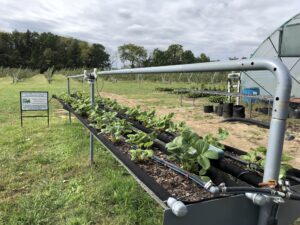
An example of the variables being monitored by the automated irrigation system is shown here. stawberry-data_20181
A picture of an elevated strawberry system misting plants in July is shown here. 2019-02-07-ISBF
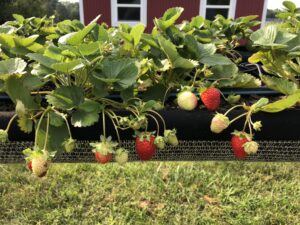
Cultivars used in this project include both June-bearing and Ever-bearing varieties so that the system can be evaluated for overall fruit quality and yields as well as season extension capabilities.
Prototype systems were set up at all three farms. During the growing season, it became apparent that design modifications could be made to lower the cost to purchase and install this type of system. With our original considerations in mind regarding the need to control heat build up as much as possible, the system's design was changed from using "troughs" to "bags". Both troughs and bags are made of the same breathable material that allows for an evaporative cooling effect. However, the bags are easier to move and do not require as much structural support as the troughs.
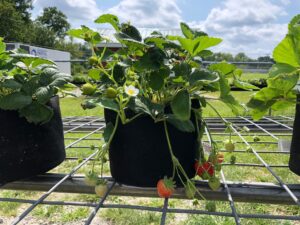
No yield or cultivar performance data is reported here. Due to delays in getting the system's wireless network operational and excessive rains, our field trials were not set up until after the spring crop for all varieties.
In years three and four, Indian Springs Berry Farm did not participate in the Research. They were however engaged with feedback from their customers and desire to install the system at their blackberry farm this next year.
Rhoads Farms is one of the largest plastic-culture strawberry growers in Ohio. Brett Rhoads has continued to consult Tanglewood Berry Farm on best growing practices and strawberry cultivar trials and recommendations for our system. Rhoades Farms is planning to install a bench system this next year.
In years three and four, we have refined our system greatly. So much so that the system is being commercially produced and offered to the public, including both hobbyists and commercial growers. After an open house in 2019, a local AgriBusiness company, Biodyne USA, approached us to jointly commercialize and market the elevated strawberry bench system. This new joint venture is IBEX Growing Systems. www.ibexgrows.com. Much of the current and future outreach will continue through IBEX Growing Systems. IBEX not only offers the hardware for this system but the supplies and support to successfully grow and commercialize strawberries. Interested growers that need more specific information are welcome to contact IBEX Growing Systems through our website.
In regard to our other Project Objectives:
- Over the last four seasons, we have trialed 9 strawberry varieties. We have selected three day-neutral varieties, Albion, Seascape, and Evie2. These varieties grow well in containers and were selected for their flavor, appearance, yields, disease resistance, and firmness. In year 4, we had a controlled planting in-ground and on plastic. Here are some key comparisons we monitored and logged:
- We planted bare-root plants in the month of July. Planting was timed to begin harvest by the end of August. Temperatures above 85 degrees F can shut down strawberry plants and high temperatures can damage pollination. Also, high temperatures can affect fruit quality and flavor. In order to manage the timing of fruit set and harvest, both the early flower blossoms and runners need to be pinched back. This also allows the plant to grow to better support fruit production. On the bench system, it is very quick and simple to pinch back the blossoms and runners. It is not practical when the plants are on the grounds. Our u-pick customers totally preferred the bench system over the ground planted berries. We are able to extend the harvest season in fall by deploying the poly cover before a frost event. When the temperatures are below 28 degrees F, we have a misting system that sprays a light mist under the tunnel onto the plants. This will protect the plants to 22 degrees F through the freeze event. This can be manually or sensor activated. When the fall harvest comes to an end, the bags with plants are set directly under the benches and covered for the winter. The bags are then uncovered but left on the ground in April. When the frost is imminent the plants are covered for protection. Generally, by the end of April, the plants are set back onto the benches, and drip stakes re-inserted into the bags. Depending on the spring weather, we will begin harvesting the middle to end of May, before the ground strawberries begin. Harvest will last for three to 5 weeks, plants are discarded and pots are replanted with new bare-root plants. This process is repeated each year. We had many elderly and handicap challenged customers who could enjoy picking their own that otherwise would not have been able. The quality of the bench berries was far superior to the ground strawberries. So far this season, we have culled approximately 24% of the ready-picked ground strawberries versus less than 3% for the bench grown strawberries. This was due to disease, pests, and rain events.
- The benefits of worker welfare with the bench system compared to the in-ground strawberries is incredible. By eliminating the stoop labor issue, we believe that with this system, it will be easier for small to mid-size growers to find local labor. As an example, we have had several customers offer to come and pick for free just because they enjoy the exercise and experience.
Compared to matted-row strawberries, there is absolutely no comparison. In order to time our harvest for the late summer/fall period, the plant blossoms and runners need to be pinched back. This allows the plant to build its root system and support a larger crop sooner. This is not economically practical for the in-ground strawberries. Our workers would pinch back while they were watering or we would have the farm store girls pinch back when they had a lull in customers. It was difficult to get an accurate comparison in regard to reduced harvest time but can conservatively say it was under half. We did notice that U-Pick customers would pick more off the bench because of the ease. One time study with our professional pickers picking was 10 lbs. from the bench and 4.2 lbs. on the matted rows.
- We have had 4 versions of controllers and sensors over the four seasons. We have identified Galcon 9000 the best controller for residential use or hobbyist https://galconc.com/product/s-9000/. For the small to midsize growers the Hunter NODe BT https://www.hunterindustries.com/irrigation-product/controllers/node-bt. There are dozens of soil sensors available at different price points. Hunter Industries can recommend sensor types and brands for connecting to the NODE BT.
- The use of the reflective Aluminet brand shade netting was used when temperatures were above 84 degrees F. We could reduce the temperature at the plant level by as much as 6 degrees F vs ambient. This can be significant in some conditions. In some areas of the country with higher temperatures, this can be an option.
- Because of the coronavirus, we were unable to host the larger field day at Tanglewood. We have had many Ag industry people to the farm in small groups as well as local extension, university, and FSA people. We have had on display our strawberry bench system at Tanglewood and have been open for berry sales, both ready-picked and you pick which has been seen by hundreds of customers. In addition, we were unable to set events with Gary Gao, OSU Extension, and Bob Kline at the Columbus Ohio Youth Garden. We have though been in contact with both and will continue our outreach through IBEX Growing Systems.
Educational & Outreach Activities
Participation Summary:
See Research Results and Discussion
Learning Outcomes
Big Springs Proforma-SB 06.12.20Lessons learned:
Growing medium - we experimented with different types and blends of growing medium. We learned that the aeration is critical so as not to waterlog the plants. An ideal recipe is 45% coconut coir, 40% white peat, and 15% vermiculite or pearlite. Other growing media including soil can be used but always use vermiculite or pearlite for the aeration. We did experiment with regrinding the one-year-old medium including the plant roots. This appeared to breakdown the coir and peat fibers and made a more dense medium which was difficult not to over saturate. This causes some black root rot and phytophthora fungal disease.
Growing bags: We use a felt-like fabric pot which was ideal for keeping the growing medium and plant cooler through its evaporative cooling ability. The bench system is amendable to plastic grow bags as well. However, the fabric bags will last for many years and are more ecologically friendly.
Strawberry Varieties: We trialed many strawberry varieties focusing on flavor, yield, heat, and disease resistance, and concluded that Albion, Seascape, and Evie2 were ideal for the bench type growing.
Nutrients: We found that when planting the bare-root plants, adding some slow-release fertilizer prills helps sustain the plants for the growing and harvest seasons along with injecting N-P-K + micronutrients every week from the first blossom through harvest.
Pest Management: The bench system greatly increases the quality of fruit. This system allows for air circulation throughout the plant canopy greatly reducing fungal disease. Other pests such as squirrels, chipmunks, and birds find it difficult to access the fruit. A bird netting can be deployed over the hoops when needed. We did not have any bird issues at our farm.
Irrigation: Each bag has a drip stake emitter. Adequate flow and pressure, min. 7 psi, is required to achieve even flow over the entire network of bags.
Labor: Compared to matted-row strawberries, there is absolutely no comparison. In order to time our harvest for the late summer/fall period, the plant blossoms and runners need to be pinched back. This allows the plant to build its root system and support a larger crop sooner. This is not economically practical for the in-ground strawberries. Our workers would pinch back while they were watering or we would have the farm store girls pinch back when they had a lull in customers. It was difficult to get an accurate comparison in regard to reduced harvest time but can conservatively say it was under half. We did notice that U-Pick customers would pick more off the bench because of the ease. One time study with our professional pickers picking was 10 lbs. from the bench and 4.2 lbs. on the matted rows.
Return on Investment: Attached is a Proforma for 9 - 102' strawberry benches. By cropping a spring and late summer/fall crop in the Midwest climate, a less than 2-year return on investment is possible when purchasing the bench product. This would be for a U-Pick or a Ready-Pick or combination of the two. A better return on investment would be possible with a DIY approach to the bench hardware.
Project Outcomes
This has been an incredible opportunity and success. It has been difficult the last six months to fulfill our original outreach plans but with the commercialization of this technology developed with the assistance of this SARE grant, we will continue to educate and offer systems through IBEX Growing Systems. To date, we have set up four commercial farms with the strawberry bench system in Indiana and Iowa. We are launching the strawberry bench system kit (12 ft. bench) this month via e-commerce.
Much of what we have learned in developing this technology for the strawberry bench system can be applied to other crops as well. We hope to develop new systems in the future for the specialty crop industry.
